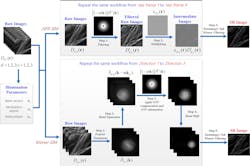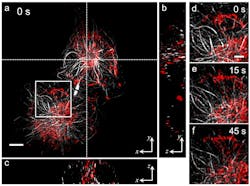Existing super-resolution (SR) fluorescence microscopy techniques offer unprecedented spatial resolution, but present challenges. A new algorithm overcomes them and enhances bioimaging techniques altogether.
Super-resolution structured illumination microscopy (SR-SIM) is a patterned illumination-based approach widely used for live-cell imaging. It provides high temporal resolution, minimal photon damage, low photobleaching, and fast imaging rates. Known as a revolutionary subset, SIM is compatible with conventional fluorophores, it offers higher contrast than traditional widefield microscopy, and provides fast recordings of large fields of view.
But it’s not without flaws. “The current reconstruction algorithm for SR-SIM imposes a significant computing burden due to a complex workflow and a large number of calculations,” says researcher Ming Lei, a professor in the Xi’an Jiaotong University School of Physics in China.
He points out a “missing cone problem” as well, which is a range of missing data in a spatial frequency domain along the rotation axis of illumination on a sample.
With SR-SIM, researchers must first use a microscope’s wide-field mode to navigate the field of view, then switch to SR mode to acquire raw images for reconstruction. It results in wait times of up to 8 seconds for observing and reconstructing a single 1024 × 1024-pixel SR image after dedicated postprocessing.
“This nullifies real-time imaging, as more than a few seconds are required to reconstruct a single super-resolution image,” says Lei. “The disjointed workflow of SIM setups inevitably impedes its widespread application among biologists.”
To address the lagging reconstruction speed and missing cone problems, the team developed a rapid joint space and frequency reconstruction (JSFR) SIM method, which provides improved image reconstruction speed and suppression of the out-of-focus background in thick cells.
How does JSFR-SIM work?
Most SIM reconstruction algorithms are based on the Wiener filter protocol, which essentially filters out noise from a corrupted signal to provide an estimate of the underlying signal of interest and optimizes contrast in the available signal-to-noise ratio. The complex workflow of Wiener-SIM makes super-resolution reconstruction extremely time-consuming, according to the researchers, which limits the utility of SR-SIM as a live-cell imaging modality.
JSFR-SIM is a concise reconstruction protocol to rapidly obtain optically sectioned, super-resolution images of thick specimens by combining spatial domain processing with the conventional workflow implemented in the frequency domain (see Fig. 1).
Most Fourier-domain operations are replaced with simple multiplication and summation calculations in real space. And the JSFR-SIM algorithm fundamentally overcomes the limited reconstruction speed of conventional reconstruction methods.
“The main advantage of JSFR-SIM is its unrivaled reconstruction speed,” Lei says. The team found that the execution time of the reconstruction is reduced to millisecond level with the new algorithm, “which is measured to be 80x faster than the widely used Wiener-SIM. Critically, the speed increase does not come at the expense of image quality.”
JSFR-SIM is specifically a powerful tool for real-time, super-resolution imaging of subcellular dynamics. Among its potential applications is the investigation of mitochondria. Lei says in such work, mitochondrial cristae are the main features of interest (see Fig. 2).But they can’t be resolved using wide-field fluorescence microscopy. Lei says that with conventional SR-SIM, in the absence of real-time, high-resolution, background-free feedback, locating the field of view is “a laborious and time-consuming process.”
By this time this is complete, the biological process may already be complete, or critical data missed entirely. “In sharp contrast, with JSFR-SIM, microscope users will initiate imaging in SR mode, navigate to a field of view, and obtain the SR image in less than 100 ms,” he says. “Locating the ideal field of view aided by JSFR-SIM is an easy process that enables the routine visualization of the dynamics in the super-resolved structure of mitochondria.”
This breakthrough promises to make real-time super-resolution imaging “a routine tool in biomedical imaging,” Lei says. “It can greatly improve biologists’ efficiency.”
About the Author
Justine Murphy
Multimedia Director, Digital Infrastructure
Justine Murphy is the multimedia director for Endeavor Business Media's Digital Infrastructure Group. She is a multiple award-winning writer and editor with more 20 years of experience in newspaper publishing as well as public relations, marketing, and communications. For nearly 10 years, she has covered all facets of the optics and photonics industry as an editor, writer, web news anchor, and podcast host for an internationally reaching magazine publishing company. Her work has earned accolades from the New England Press Association as well as the SIIA/Jesse H. Neal Awards. She received a B.A. from the Massachusetts College of Liberal Arts.


